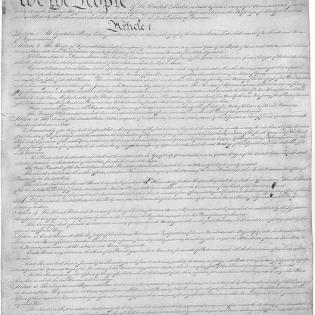U.S. Constitution: Significance and Structure
Students identify key events in U.S. history and the magnitude of the Constitution in context, with a particular emphasis on philanthropy. This lesson is designed for Citizenship/Constitution Day (September 17) and connects students to the historical significance of the Constitution and how it relates personally to their lives and action.
The learner will
- define philanthropy as giving or taking action for the sake of others or the common good.
- identify the Preamble, articles, and Bill of Rights in the Constitution.
- distinguish the Constitution from the Declaration of Independence, and identify other significant events in U.S. History.
- state things citizens can do to honor the words of the Constitution.
- projector
- student copies of handouts
- teacher copies of answer keys in handouts below
- PowerPoint presentation below
This video may be used as reinforcement or homework, or for absent students. It covers the content of the PowerPoint.
- philanthropy: giving or taking action for others or the common good
- Constitution: the rules and structure for the U.S. system of government
- Preamble: the introduction to the Constitution describing its purpose
- Checks and balances assure that each branch of government has powers to balance and keep the others from gaining too much power.
- Bill of Rights are the first ten Amendments to the Constitution.
- U.S. Constitution establishes a system of government that has powers, responsibilities, and limits that have changed over time and that are still contested.
What can you do to make the world a better place, with the words of the Constitution in mind?
Instructions
Anticipatory Set
Put students into groups and give each group a “Scrambled History” handout. They connect events in history with years in a timeline. You may require they do it from memory or allow them to use resources for research. You may give a prize or recognition to the group that completes the sheet correctly first. (15 minutes)
Project the answer key, discuss, and have students fill in missing portions of their worksheet.
Project the PowerPoint to discuss the magnitude of the Constitution in U.S. history and how it calls people to be active participants, with rights and responsibilities. (PPT handout below)
The second slide poses a question that segues from this first activity. It poses the claim that the creation of the U.S. Constitution is the most important event in U.S. History. Have students support, extend, or challenge this claim. This can be via whole class discussion, reflective writing, or small group discussions. (15 minutes)
Continue with the PowerPoint in conjunction with a lecture about the structure and purpose of the Constitution. Have students take notes, either using the provided note outline handout, or by taking the notes on their own. (20 minutes)
Define philanthropy as giving and taking action for the common good. Discuss the role of philanthropy, including responsibility and generosity toward the good of all in the Constitution and in U.S. success. Do you think U.S. citizens feel a responsibility to make the greater society work?
The Federalist Papers were written to persuade states to ratify the Constitution. They help us understand the Constitution purpose and meaning.
Formative Assessment: Give students the Federalist Paper Number One handout below. They read the excerpt and answer three questions about the value of philanthropy. (10 minutes)
Formative Assessment: What have you learned today? (10 minutes)
Philanthropy Framework
-
Strand PHIL.I Definitions of Philanthropy
-
Standard DP 01. Define Philanthropy
-
Benchmark HS.3 Explain and give examples of how a democratic constitution requires and protects philanthropic behavior as a democratic principle.
-
-
-
Strand PHIL.II Philanthropy and Civil Society
-
Standard PCS 06. Philanthropy in History
-
Benchmark HS.3 Describe important events in the growth and maturation of the civil-society sector in the nation and world.
-
-
